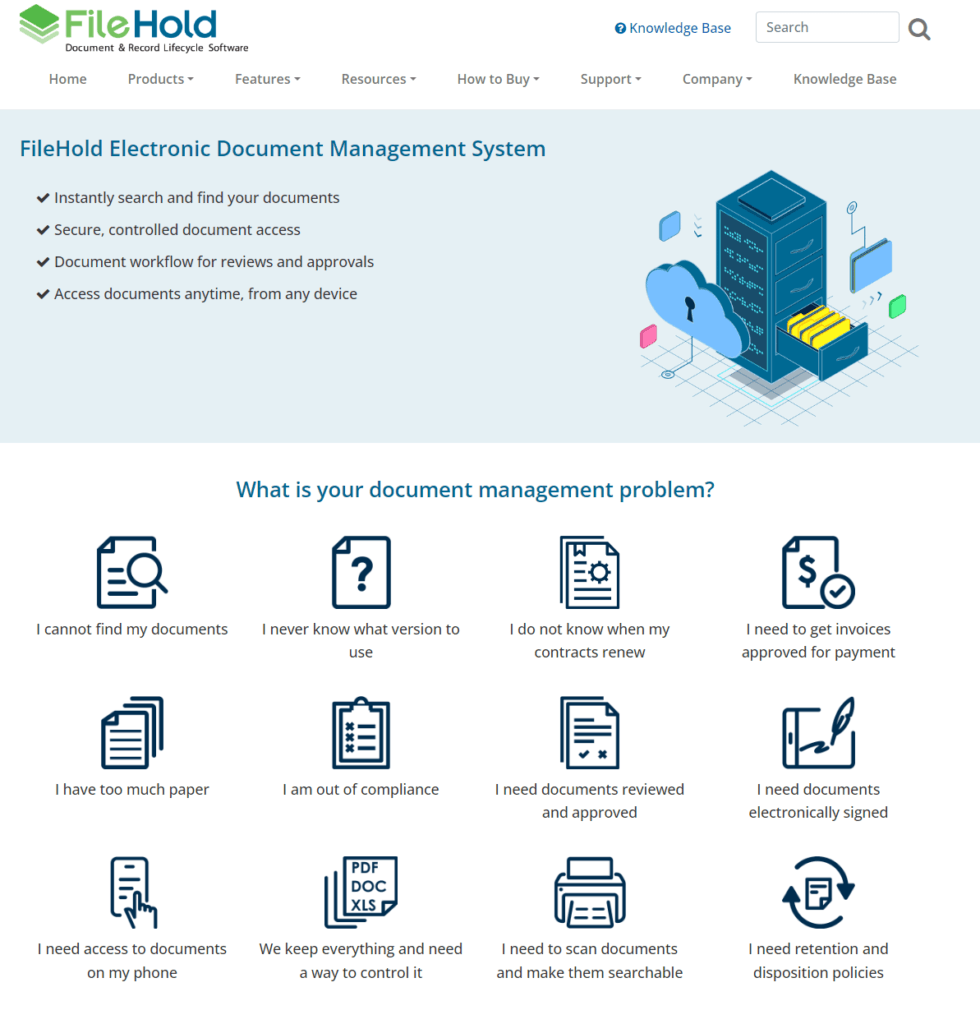In the modern business landscape, choosing the right document management tool is critical for staying organized and efficient. Today, we’re taking a close look at FileHold and Samepage to determine which might be the best document management solution for your needs. Both platforms offer robust features, but they cater to slightly different audiences. Let’s dive into their core functionalities to see how they stack up.
FileHold | Samepage |
|---|---|
| G2 Score – 4.6 out of 5 stars | G2 Score – 4.5 out of 5 stars |
| TrustRadius Score – 7.1/10 | TrustRadius Score – 8.1/10 |
Integration Capabilities: Connecting Your Business Tools
In the fast-paced world of business technology, the ability of a document management tool to integrate seamlessly with existing systems significantly enhances its utility and efficiency. Both FileHold and Samepage offer integration options, but they cater to different kinds of operational needs based on their primary functionalities.
FileHold: Enhanced Enterprise Integration
FileHold is exceptionally strong when it comes to integrating with enterprise-level systems, particularly those that are ubiquitous in corporate environments like Microsoft Office and SharePoint. This integration is facilitated through a well-documented API that allows for deep, custom integration efforts. For organizations that operate within a Microsoft-centric infrastructure, FileHold provides a seamless extension, enhancing document management capabilities without disrupting existing workflows.
Beyond basic software integration, FileHold offers powerful tools for automating workflows within the document management system. This capability allows businesses to automate processes such as document approvals, reviews, and archiving which can be crucial for maintaining efficiency and compliance in industries that are heavily regulated or document-intensive.
Samepage: Flexible and Broad Collaboration Tool Integration
Samepage shines with its ability to integrate smoothly with a wide range of cloud-based productivity tools including calendar apps, email, and even social media platforms. This broad range of integration capabilities is designed to enhance user experience and facilitate collaboration, allowing users to work directly on documents stored in Samepage without switching between different applications.
Additionally, Samepage boasts an extensive ecosystem of third-party apps available through integration platforms like Zapier. This flexibility makes it possible for teams to customize Samepage to fit a wide array of needs and workflows, from project management to customer relationship management, enhancing its utility as a central hub for collaborative work.
User Experience and Accessibility: Key to Effective Software Adoption
Both FileHold and Samepage aim to provide a seamless user experience but focus on different aspects of usability based on their primary functions as a document management system and a collaboration platform, respectively.
FileHold: Focused on Functionality and Familiarity
FileHold offers a user interface that closely resembles traditional desktop file systems, which can be comforting to users accustomed to such environments. It’s designed to manage complex document libraries effectively, making it ideal for organizations with extensive document management needs. The interface is straightforward but packed with powerful features accessible through menus and right-click options.
FileHold is accessible via a desktop client and a web browser. This dual access ensures that users can manage documents effectively whether they are in the office or working remotely. The desktop version offers a full range of features, while the web version provides essential functionalities, making it versatile for various user needs.
While FileHold is feature-rich, it prioritizes a user experience that minimizes the learning curve. It includes drag-and-drop capabilities, customizable metadata fields, and intuitive navigation paths, all designed to simplify the document management process. However, due to its robust feature set, new users might require some initial training to fully utilize all its capabilities.
Samepage: Streamlining Collaboration and Interaction
Samepage is known for its clean, intuitive interface that facilitates easy navigation and collaboration. The platform is designed to be user-friendly, supporting real-time document collaboration, task management, and communication in a single window. Its interface integrates text, chat, task lists, and files in a way that reduces the need to switch between different apps or tabs.
As a cloud-native solution, Samepage excels in accessibility. Users can access the platform from any device with internet connectivity, ensuring they can collaborate and manage documents from anywhere. This is particularly beneficial for teams that operate remotely or have members who travel frequently.
Samepage shines in user-friendliness, especially for teams that need a collaborative platform that is easy to adopt and use. Onboarding new users is generally quick, thanks to its intuitive design and minimalistic approach. The platform also offers helpful tutorials and customer support to assist users in navigating its features.

Related: Check out our free SEO suite

Pricing and Customer Support: Balancing Cost with Quality
Both FileHold and Samepage offer structured pricing models and customer support designed to meet various organizational needs and budgets. Let’s look at how each platform handles these crucial areas.
FileHold: Structured Pricing for Scalable Solutions
FileHold’s pricing is typically based on the number of users and the server type (on-premise or cloud-based), with costs scaling accordingly. This tiered pricing model allows businesses to scale their usage as needed and select a plan that fits their budget and document management requirements. FileHold may also require a one-time purchase or licensing fee, particularly for the on-premise version, which could be an important consideration for capital expenditure planning.
FileHold provides comprehensive customer support, which includes access to training sessions, detailed documentation, and responsive technical support via phone, email, and an online customer portal. The level of support can depend on the subscription plan, with higher-tier plans typically offering more extensive direct support options. This structured support is beneficial for organizations that require hands-on assistance and quick resolutions to ensure smooth system operations.
Samepage: Flexible Pricing with Extensive Support
Samepage offers a flexible pricing model that primarily depends on the features required and the number of team members. The platform provides a free tier with basic functionality, which is great for small teams or startups just beginning to coordinate their efforts. Paid plans include more advanced features, such as additional storage, more extensive administrative controls, and advanced team collaboration tools. These plans are competitively priced and billed either monthly or annually, providing flexibility to adjust as your team grows or changes.
Samepage shines in its support offerings, particularly through its extensive online resources and active community forums. The platform also provides direct customer support via live chat and email. The responsiveness of Samepage’s support team is often highlighted in user reviews, and the company places a strong emphasis on ensuring users can leverage the platform to its fullest potential without significant downtime.
Scalability and System Performance: Ensuring Future-Proof Functionality
Both FileHold and Samepage are designed to support business growth, but they handle scalability and performance in different ways to cater to their specific user bases.
FileHold: Engineered for Enterprise Growth
FileHold is built to scale efficiently from small business setups to large enterprise configurations. It supports an extensive number of users and can handle a significant volume of documents without degradation in performance. This scalability is particularly important for organizations that anticipate growth in document volume and complexity.
FileHold’s performance is optimized for handling large-scale document management tasks. Its system architecture is robust, ensuring that search functions, document retrieval, and workflow operations remain fast and efficient, even as the system scales. This is crucial for maintaining productivity as more users and documents are added to the system.
Samepage: Flexibility for Dynamic Team Environments
Samepage is designed with cloud-based scalability in mind, making it an excellent choice for teams that need flexibility in terms of user access and collaboration volume. It adjusts easily to the changing needs of businesses, whether scaling up for large projects or down during quieter periods. The platform’s cloud infrastructure ensures that resources are efficiently allocated to match demand.
Samepage excels in maintaining high performance across its collaborative tools and document management features. The platform ensures that updates, document access, and communication tools operate seamlessly in real-time, which is essential for teams that rely on instant information sharing and collaboration. This performance level is maintained regardless of the number of simultaneous users, which is beneficial for teams spread across various locations.
Document Security and Privacy: Safeguarding Your Data
Both FileHold and Samepage recognize the importance of data security, but their approaches and the robustness of their features can vary significantly, reflecting their target user bases and core functionalities.
FileHold: Rigorous Security Measures for Sensitive Information
FileHold is particularly strong in its security offerings, designed to meet the needs of organizations that handle sensitive and critical documents. It includes comprehensive access controls, allowing administrators to set detailed permissions on who can view or edit documents. This is complemented by robust encryption protocols for data at rest and in transit, ensuring that documents are protected from unauthorized access.
FileHold excels in environments that demand strict compliance with regulatory standards. It supports compliance with regulations such as HIPAA, GDPR, and others by providing features like audit trails, which track and record all actions taken on documents. This capability is crucial for industries where maintaining the integrity and confidentiality of documents is required by law.
Samepage: Collaborative Security with a Focus on Teamwork
While Samepage offers solid security measures, its focus is more on facilitating collaboration in a secure environment rather than on strict document control. It provides essential security features like SSL/TLS encryption, two-factor authentication, and automated backups, which ensure a high level of data protection for everyday business use.
Samepage also ensures data privacy and supports general compliance requirements suitable for most businesses. While it may not have as extensive compliance-specific features as FileHold, it offers enough to satisfy the needs of teams whose primary concern isn’t stringent regulatory adherence but rather secure and effective collaboration.
Pricing
FileHold:

Samepage:

Conclusion
In concluding our comprehensive comparison between FileHold and Samepage, we’ve dissected multiple facets crucial for any organization considering a new document management system (DMS). Both platforms offer robust features tailored to enhance different aspects of document management and collaboration, but they cater to distinctly different needs.
FileHold is tailored for organizations that require a robust, feature-rich document management system. It excels in environments that demand strict document control, extensive security measures, and compliance with regulatory standards. FileHold’s strengths include advanced document indexing and search, secure access controls, detailed audit trails, and powerful workflow automation. It’s particularly suitable for industries like legal, healthcare, and government, where such features are essential.
Samepage, on the other hand, shines as a collaborative platform that integrates document management within a broader suite of communication and project management tools. It is designed for dynamic team environments where collaboration, ease of use, and integration with other cloud-based tools are priorities. With features supporting real-time document editing, seamless integration, and user-friendly interfaces, Samepage is ideal for teams that need to stay connected and productive in a flexible and less regulated environment.
Read Next:
- GetResponse vs Zoho Campaigns: The Best Email Marketing Tool for 2024
- AWeber vs ActiveCampaign: The Best Email Marketing Tool
- Constant Contact vs Campaigner: Best Email Marketing Tool
- GetResponse vs Omnisend: The Best Email Marketing Tool for 2024
- AWeber vs Benchmark Email: The Best Email Marketing Tool






















Comments are closed.